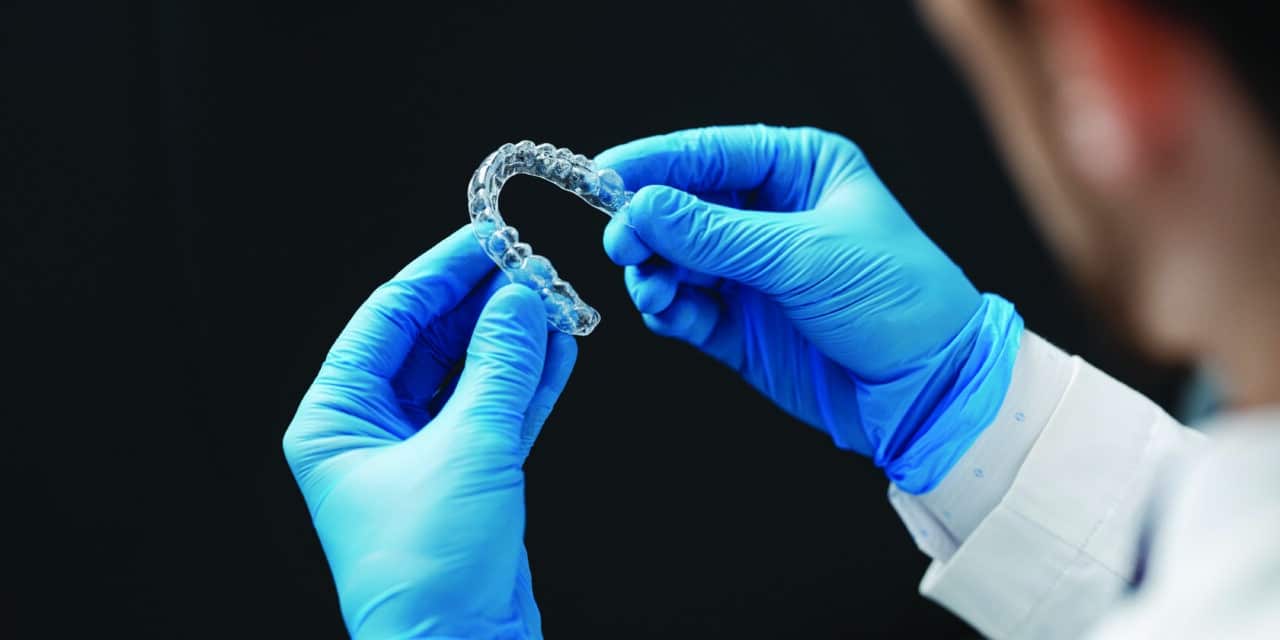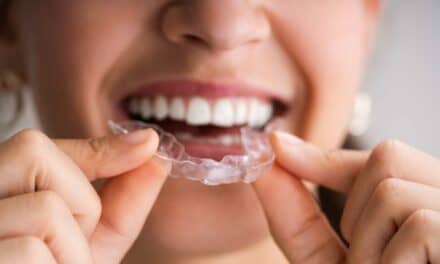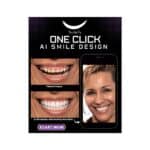Early adopters are replacing vacuum formers with 3D printers that build aligners layer by layer.
By Alison Werner
In-office direct-print aligners (DPAs) are no longer a future concept. The technology now exists—and is being used—to deliver aligners printed directly from digital setups without the need for a model or vacuum-forming sheet. While still in its early stages, DPAs are giving technology-forward orthodontic practices another way to take more control over aligner design, workflow, and cost.
For now, the process requires a higher level of digital fluency than most in-office aligner systems. But early adopters say that once the workflow is mastered, the advantages are hard to ignore: a more precise fit, fewer attachments, faster turnaround, and less material waste.
What Are Direct-Print Aligners?
Traditional in-office aligners start with a printed model. A plastic sheet is heated and vacuum-formed over the model, trimmed, and polished before delivery. The result is functional but not perfectly uniform. The plastic stretches over the high points of the model and thins over the edges, creating small variations in thickness that can affect how the aligner delivers force.
Direct-print aligners change that approach. Instead of printing a model, the aligner itself is produced layer by layer from a light-cured resin. Each tray is generated directly from the digital treatment plan, allowing for uniform thickness and a design that matches every tooth surface exactly.
Because the appliance is built digitally, the aligner can include features—such as dimples for retention, bite ramps, or cutouts—during the design stage, without additional lab steps. The result is a cleaner, more efficient fabrication process that gives orthodontists new ways to control both fit and biomechanics.
Two Systems, Two Approaches
At present, Lux Creo and Graphy are the main two companies in the space with FDA-cleared resins for direct-print aligners. Both use photopolymer materials designed to maintain elasticity and recover their original form when heated—a property often described as “shape memory.” That thermal response helps maintain consistent force over time and allows the aligner to be reactivated in hot water if it becomes distorted.
LuxCreo’s system takes a closed-platform approach. Its resin, printer, wash unit, oven, and curing box are calibrated to work as one system, with defined parameters for each stage of production. Graphy, on the other hand, follows an open-platform model. Its resin can be used with multiple validated printers, as long as the practice follows a precise post-processing workflow that includes washing, centrifuging, and curing steps.
While the two companies take different routes, the goal is similar: to give orthodontists the ability to produce aligners directly in-office, with control over design and manufacturing that previously required outsourcing.
Early Adoption and What’s Driving It
Direct-print aligners remain a small but steadily growing category, driven largely by practices that already operate digital labs. For these early adopters, DPAs represent the logical next step in the evolution of in-office production—moving from retainers and IDB trays to fully functional treatment appliances.
The appeal lies in greater control and responsiveness. Aligners can be printed and delivered the same day, without the time and cost associated with third-party labs. The digital workflow also allows for more customization, from thickness mapping to margin design, and eliminates the need to print and dispose of plastic models—reducing waste in the process.
Still, the systems come with a learning curve. Each resin has strict handling and curing requirements, and the post-processing workflow must be followed carefully to ensure the aligner is safe and accurate. Practices also need a staff member comfortable with digital file management, CAD design, and printer maintenance.
The investment of time and training, though, is part of what makes this a turning point for some orthodontists. With two FDA-cleared options on the market and more research underway, DPAs are moving from early trial to real-world clinical use. The technology is no longer theoretical—it’s operational, though still evolving.
Orthodontists who have already implemented direct-print workflows say the technology is reshaping how they think about production, precision, and patient experience. The approach is still developing, but its potential is clear: faster turnaround, fewer materials, and the ability to fine-tune design at a level that wasn’t possible with traditional thermoforming.
Here, three clinicians share how they’ve incorporated direct-print aligners into their practices, what challenges they’ve encountered, and how they see the technology evolving in the years ahead.
Precision and Practicality: Dr Bill Layman’s LuxCreo Workflow
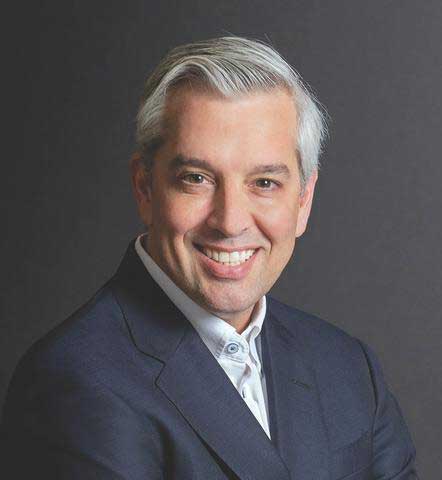
When Bill Layman, DMD, MBA, began working with LuxCreo’s direct-print aligner system 3 years ago, there were few roadmaps to follow. At that point, only a handful of orthodontists in the United States had access to it, and Layman—board-certified and owner of Straighten Up Orthodontics in Clearwater, Fla—was among the first to test the platform clinically. The opportunity, he says, came from both professional curiosity and a desire for greater control over aligner design and efficiency.
Layman wanted freedom to create trays with more functionality than plastic pressed over a model. “Direct printing gave me a way to design every part of the tray to match the tooth,” he says. That precision, he adds, meant fewer attachments and more predictable movement.
The Closed-Ecosystem Advantage
LuxCreo’s platform appealed to Layman because it offered a complete, validated system. The company’s resin, printer, wash unit, oven, and curing box are engineered to work together, limiting variability and reducing trial and error during early adoption. “With a new technology, I didn’t want to wonder what was causing problems. This way, if the resin didn’t perform, I’d know it wasn’t the printer or the cure,” he explains. That integration, he says, made the learning curve manageable.
LuxCreo’s shape-memory resin allows trays to return to their original printed geometry when exposed to heat, maintaining accuracy and flexibility. “It’s surprisingly durable,” he says. “You can twist it or drop it, and it won’t crack. And if it’s ever distorted, putting it in hot water restores it to its [printed] shape.”
Rethinking the In-Office Aligner Lab
Adopting LuxCreo reshaped Layman’s view of in-office production. The biggest early change was time savings. “Our hands-on time has gone down about 40 percent,” says Layman, who also lectures for the company. “With one lab tech and two printers running, we can do more in a day than we used to in a week.”
The workflow begins with a digital scan and uAssist setup (uLab Systems). Once approved, the file is imported into LuxDesign for shell generation and sent to LuxFlow for printing. Each tray is washed twice, oven-cured, and finished under UV light before polishing and packaging. Layman estimates about 6 minutes of true hands-on time per tray—less than half of what thermoforming required. “Before, we were building aligners,” he says. “Now we’re managing a process. It’s a totally different mindset.”
Attachments and Fit
The precision of direct printing has allowed Layman to minimize bonded attachments. He now uses what he calls “negative attachments”—small indentations printed into the tray to create targeted pressure points. Patients, he says, appreciate the smoother surfaces and easier hygiene.
That accuracy has also improved tracking. “Thermoformed trays can sometimes act like socks on a rooster—they don’t grab every surface,” he says. “With direct print, [the tray] hugs the tooth, so the force transfer is cleaner. What you design into the movement, you actually get.”
Cost, Capacity, and Case Selection
Layman limits in-office production to smaller cases—roughly 10 aligners or fewer per arch—while larger, more complex treatments still run through his uLab workflow. Producing aligners in-office costs about $12 to $13 per tray versus $20 to $25 from outside vendors. Combined with faster turnaround, the workflow has become both cost-effective and practical.
By eliminating printed models and thermoforming sheets, he estimates plastic waste has dropped more than 70 percent. Trays are produced in small batches, usually no more than two dozen at a time, so if tracking drifts, fewer trays are discarded and treatment can be recalibrated midstream.
Measuring Results and Looking Ahead
After 3 years of daily use, Layman considers direct-print aligners a routine part of his workflow rather than an experiment. He’s now tracking refinement rates, attachment use, and efficiency to quantify results, but early impressions already show a difference.
“For the first time, I’ve had cases come back for a refinement, and there was really nothing to do,” he says. “Now, this was a superstar patient that wore their aligners exactly as they were supposed to, but I’ve never had that with thermoform.”
Layman continues collaborating with LuxCreo’s engineers to streamline the design process, flagging bottlenecks and suggesting automation for repetitive steps. As software evolves, he expects many manual adjustments to become built-in functions. For him, the progression feels familiar: orthodontics is, he says, simply “taking the next logical step,” building on what began when clinicians first brought aligner fabrication in-office.
Precision Without Attachments: Dr Svitlana Koval’s Graphy Workflow

Svitlana Koval, DMD, MSc, BDS, is the owner of Dr Koval Orthodontics, an airway-focused, aligner-only practice in Boca Raton, Fla; founder of the MARPEFACE Education and Research Center; and a Diplomate of the American Board of Dental Sleep Medicine. From the start, her clinical philosophy has emphasized customized treatment grounded in airway and skeletal development. So when 3D-printed aligner materials became viable, adoption was a natural progression.
Koval introduced direct-print aligners into her practice 2 years ago, becoming an early U.S. adopter of Graphy’s resin system. Her practice was already fully digital and aligner-only, so transitioning to printing aligners directly from digital setups required no philosophical shift—only a new workflow. “Our printers run 9 to 5,” she says. “We print aligners for every patient—children, adolescents, and adults.”
An Open Platform With Research Roots
Koval was drawn to Graphy’s open-platform model and scientific foundation. “I was looking for a product with a very solid research background and safety data,” she explains, citing work led by Drs Ravindra Nanda and Kenji Ojima, who have studied and lectured on the company’s materials. That research, coupled with her own experience, gave her the confidence to make Graphy a core part of her treatment system.
Graphy’s shape-memory resin is designed to soften at warm water or oral temperature, then return to its printed form as it cools. This responsiveness provides consistent, physiologic levels of force—what Koval calls “constant emitted force.” The result, she says, is more predictable movement with less need for mechanical aids.
“I am very confident in all the movements I’m planning,” Koval says. “I know which movements direct-print aligners—Graphy in particular—are good at: mesial movement, distalization, rotation. We see 70 to 85 percent efficiency for rotations and 90 to 95 percent for mesial and distal movements.” Compared to thermoformed aligners, she notes, which can drop to 50% efficiency, “you don’t need to overactivate your [digital setups]. The movements track in the patient’s mouth the way you want them to.”
Eliminating Attachments and Expanding Control
Koval’s protocols rely on the fact that Graphy does not require attachments; its extended gingival margins and flexible force dynamics provide precise control of tooth movement. This “zero-attachment protocol,” as she calls it, is now standard in her office. By increasing root coverage and bringing the point of force application closer to the tooth’s center of resistance, she says, the aligners provide precise control without bonded auxiliaries.
That control isn’t just something Koval observes in patients—it’s something she’s experienced firsthand. After undergoing her own MARPE treatment, she wore Graphy aligners herself and quickly understood the material’s behavior: slightly elastic at insertion, smooth against tissue, and tasteless. To maintain comfort and fit, she warms trays under tap water before placement and immerses them in boiled water once a day to disinfect and reactivate their shape memory—a protocol she also instructs her patients to follow.
Workflow and Staffing
Because her office was already operating a digital lab, implementation focused on training and quality control. “I did all the steps myself at the beginning,” she recalls, but now her lab team handles production from printing through inspection. Koval still directs case design while each aligner passes through Graphy’s prescribed process: printing, resin removal with a centrifuge, thermal curing, and multiple quality checks.
Her team works across several validated printers, all configured to Graphy’s parameters. “The key is following every step,” she says, noting that the material is technique-sensitive. When the workflow is respected, Koval adds, the results are consistent and reproducible.
With the system now fully integrated into her lab, Koval has shifted her focus to sharing what she’s learned.
Advocacy and Education
As a Graphy lecturer and clinical educator, Koval now trains other orthodontists on incorporating the system. She encourages peers to approach adoption methodically—starting with education and certification courses to understand the workflow. Graphy, she notes, offers starter packages that include the recommended printer, centrifuge, and curing unit, along with hands-on technical support. “You don’t need to start big,” she says. “Even one printer is enough to start off with your own cases.”
Looking ahead, Koval sees direct-print aligners and artificial intelligence as technologies on parallel paths that will increasingly intersect. She expects advances in automation to simplify treatment planning and reduce manual steps, allowing orthodontists to focus more on clinical decisions than digital execution. “Our field is evolving at a [fast] pace,” she says, and she believes the goal will remain the same—more efficient, personalized, and biologically sound care.
For Koval, direct-print aligners represent both innovation and autonomy. “It’s very exciting seeing how these new technologies work in your hands and how you can increase the efficiency of your own workflow,” she says. That sense of control, she adds, reflects where modern orthodontics is headed.
Precision by Iteration: Dr Jeremy Manuele’s Direct-Print Workflow
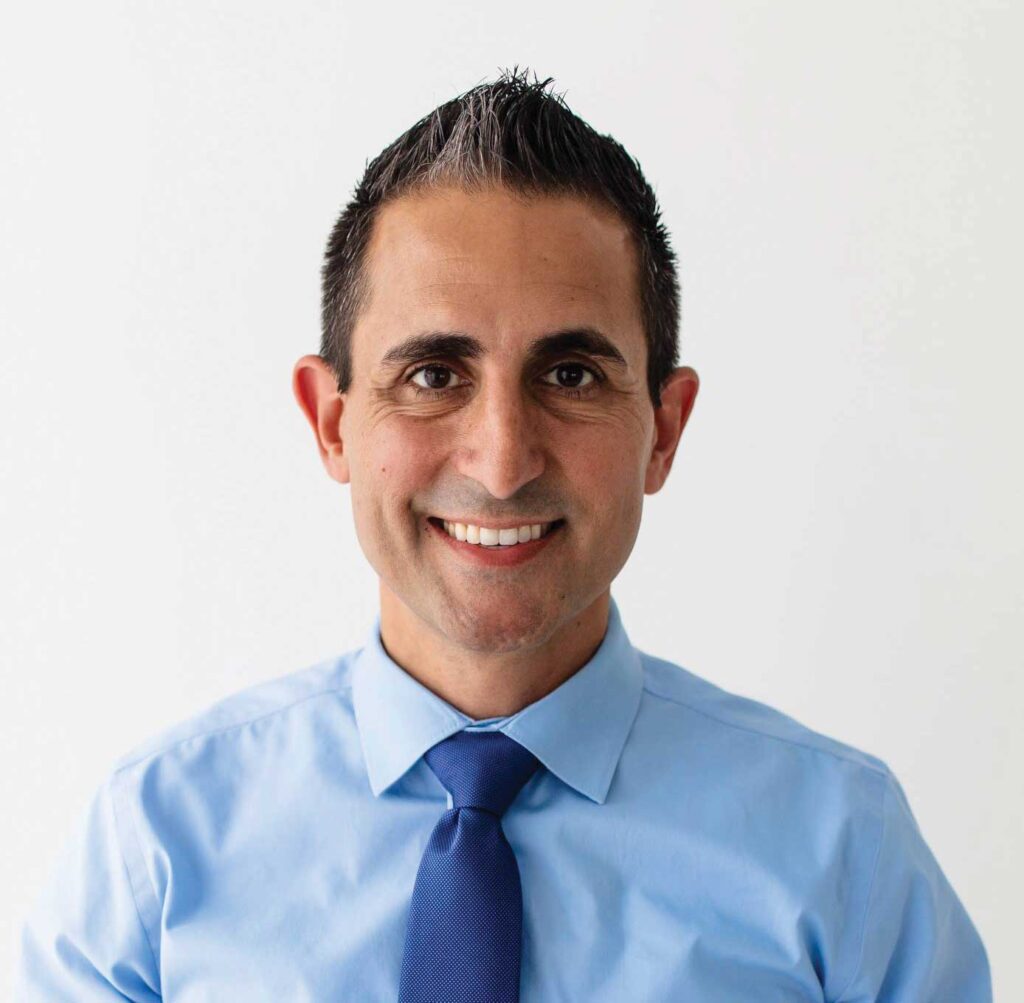
When Jeremy Manuele, DMD, of Hamilton & Manuele Orthodontics in Las Vegas began experimenting with direct-print aligners, he wasn’t trying to reinvent his lab—just refine it. His team was already producing thermoformed aligners, IDB trays, and retainers in-office. What LuxCreo’s system offered, he says, was a faster, more predictable version of what he was already doing, with fewer steps between design and delivery.
Manuele’s journey into digital workflows began nearly a decade ago, when he started printing models in-office to improve appliance fit. Fast forward to January 2025 and Manuele was installing his first LuxCreo printer to begin direct-print aligner fabrication. He first tested the technology on limited cases before moving all new starts—comprehensive, moderate, and limited—to direct-print trays over the last few months. Of the transition, he says, “Can it be plug-and-play? Sure. But it’s more like plug, flip this, switch that. You need to learn the workarounds.” Even so, he’s confident that direct printing represents the next phase of digital efficiency.
Learning the Workflow
Manuele and his digital lab technician, Melanie, run three printers: one for models, one for indirect bonding trays, and one dedicated to LuxCreo’s closed-system aligners. For him, LuxCreo’s fully integrated ecosystem—printer, resin, wash unit, oven, and curing box—was appealing because it reduced variables. “Every step is defined,” he says. “That predictability makes troubleshooting so much easier.”
The workflow starts with a digital setup in uLab. Once approved, Melanie generates the aligner shell in LuxCreo’s software, adjusting thickness and margins before sending the file to print. Each build produces up to a dozen arches in about half an hour, followed by post-processing—two alcohol washes and a heat-and-light cure—that adds roughly an hour. Most patients receive same- or next-day delivery.
“We usually print the first three aligners to get the patient started and see how they’re tracking, then do six at a time after that,” he says. “That way, if we need to make an adjustment, we haven’t wasted trays.”
Clinical Differences
Compared with thermoformed trays, Manuele says direct-printed aligners deliver a more consistent fit. Because they’re printed directly from the digital plan, each aligner fits precisely to every surface, with thickness that can be customized for comfort and control. That precision has allowed him to reduce bonded attachments. In his comprehensive cases, he typically uses between two and eight total attachments, compared with a dozen or more on traditional thermoformed aligners.
Direct printing also gives him design freedom. Built-in features such as bite ramps or buttons can be added digitally and printed as part of the aligner rather than bonded afterward. Manuele says that capability changes how orthodontists can think about biomechanics—because the aligner is no longer a sheet of plastic formed over a model, but a precisely engineered appliance built layer by layer.
Refining the Details
As one of only a handful of orthodontists in the U.S. printing aligners in-office, Manuele, who teaches at UNLV School of Dental Medicine, is still refining his process. His team continues to study how the resin behaves during curing, cleaning, and daily wear. To maintain consistency, they print aligners in small batches and use remote monitoring to track patients through weekly scans. When movement drifts, new trays are reprinted from updated designs rather than continuing through a full series. “It’s all iterative, right?” Manuele says. “You print, you test, you adjust, you go again… Every case gives you something you can make better next time.”
The Patient Protocol
Each patient leaves with printed instructions and a starter kit of Efferdent tablets, which help keep the trays fresh and improve taste. The handout explains how to reactivate the aligners each night with boiled water to restore force delivery. Because the material is printed in layers, Manuele also prepares patients for how it feels. “It doesn’t feel like sandpaper,” he explains, “but it definitely feels more rough compared to the feeling of a thermoplastic material.” Setting that expectation early, he adds, keeps patients comfortable and confident with the new system.
Looking Ahead
Manuele says his team is still in the learning phase, refining print settings and exploring how design adjustments affect performance. “We’re still learning what this stuff can do,” he says. “Every week we find something new. The tracking is just so much better, and the cases are cleaner because we’re using fewer attachments. Once you start seeing that, it’s hard to go back.”
He sees direct-print aligners as a natural continuation of orthodontics’ digital evolution. “This is just the next step,” he explains. “We went from pouring models, to printing them, to now printing the aligner itself. It’s the same curve we’ve been on for 10 years—it’s just the next logical move.” OP
Alison Werner is chief editor of Orthodontic Products.

